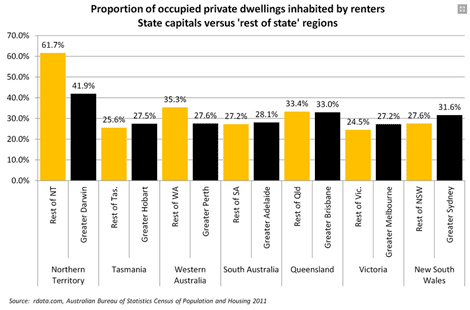Property investor guide to the suburbs dominated by tenants - highlighting private and government landlords

The proportion of dwellings that are rented has remained fairly consistent across Australia over the past decade, based on figures from the 2011 census.
Rented dwellings comprised 27.6% of all occupied homes back in 2001; 10 years later the proportion had risen by only slightly more than one percentage point to 28.7%.
The census data shows the biggest shift in dwelling tenure was seen in homes that are fully owned and homes that have a mortgage. The proportion of homes that are owned outright fell from 39.7% of all occupied private dwellings in 2001 to 31.0% in 2011. Conversely, the proportion of homes that are owned with a mortgage rose from 26.5% in 2001 to 33.3% in 2011.
Click to enlarge
The census provides some fascinating insights about the trends and geographic spread of renters. Considering that most rental accommodation is owned by private investors, analysing this data also provides an insight about where property investors have been most active (in 2011, 71.5% of all rented dwellings were privately owned, 9.4% were rented from the government and 2% were rented from community or church groups. A further 6.7% of renters fall into the "other landlord type" classification or did not respond to this question in the census).
Nationally, the proportion of dwellings occupied by renters stands at 28.7%, however there are difference from region to region. The largest states, New South Wales and Victoria, show a bias towards capital city investing with 31.6% of Sydney dwellings being rented compared with a lower 27.6% of dwellings outside of the capital city. Similarly, 27.2% of Melbourne dwellings are rented, compared with 24.5% outside of the capital city.
That trend is reversed in the mining states where investment is more popular outside of the capital cities, probably due to the high yields and capital appreciation that has been evident across the resource driven regions in both of the these states. Regional Western Australia accounts for the largest proportion of dwellings occupied by renters (apart from regional Northern Territory, which is influenced by the large number of government-supplied rental housing) at 35.3%, compared with 27.6% across the Perth market. The margin is much slimmer in Queensland, with 33.4% of regional Queensland dwellings being rented compared with 33% in Brisbane.
Of the capital cities, Darwin shows the largest proportion of investors with 41.9% of all occupied dwellings being rented. Brisbane, at 33% of all dwellings, is the second most popular capital city for investors.
Click to enlargeGetting down to a more granular level, the census suburb classifications show exactly where rental housing/investment is more or less popular. The results also provide an indication as to where social housing is most heavily concentrated. The tables below show the top 10 suburbs across each capital city based on the highest proportion of rental dwellings. We have included median house and unit prices as well as typical rental yields to provide an indication about prices and gross returns in the suburb ("n.a." indicates the suburb has recorded fewer than 10 house or unit sales or fewer than 10 rental observations over the past 12 months). It is also important to understand whether the high proportion of renters is being driven by market forces or by social housing; for this reason we have included a summary of the proportion of rental dwellings privately and non-privately owned.
It is clear to see from some of the suburbs on the list how predominant social housing is in some areas. For example, the Sydney suburbs of Claymore (97.9%), Airds (96.2%) and Daceyville (92.6%) show extremely high levels of non-private rental housing (ie. government or community/church rented). High proportions of non-private rental dwellings are also evident across the northern regions of Adelaide and eastern areas of Hobart. The benefits of integrating social housing throughout the community rather than establishing social housing "enclaves" is well documented; these examples are a stark reminder of the town planning principals that were prevalent several decades ago.
It is important to point out that some regions showing a high proportion of non-private rental dwellings are influenced by other factors such as military bases and mining sites.
Australian Capital Territory
Click to enlargeGreater Adelaide
Click to enlarge
Greater Brisbane
Click to enlarge
Greater Darwin
Click to enlarge
Greater Hobart
Click to enlarge
Greater Melbourne
Click to enlarge
Greater Sydney
Click to enlarge
Tim Lawless is national research director of RP Data.








